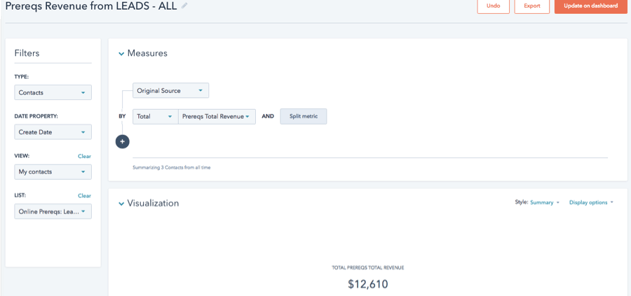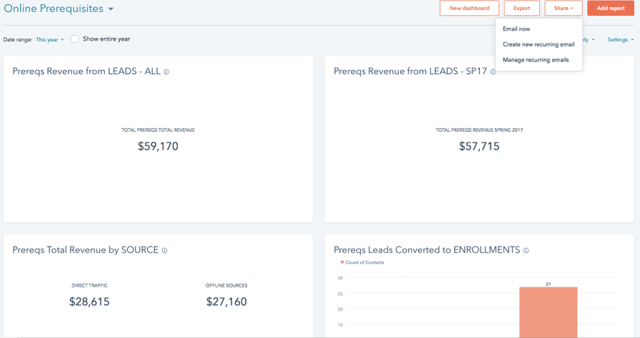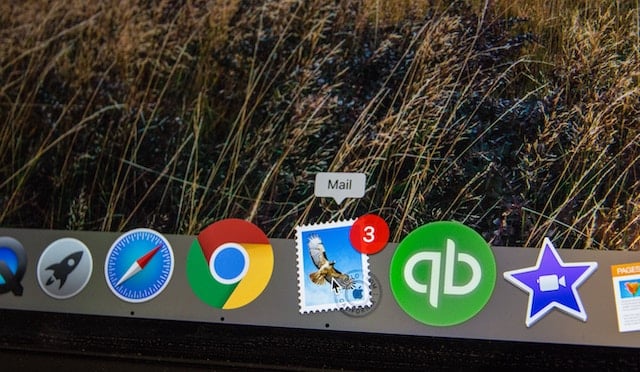At the MGH Institute of Health Professions, our main source of success has come from using HubSpot to generate leads and convert them into “customers,” or enrolled students in our online prerequisites program.

But this led to what I like to call a champagne problem: How could we track actual revenue per converted customer or enrolled student?
Tracking leads from where they originated or based on web behavior was not difficult. Our real challenge was calculating actual return on investment — ROI — on things like marketing dollars spent, results per semester and per year, and other metrics.
Achieving this was not so easy, but we did it.
We wanted to be able to track results so that we could:
- Make informed tactical marketing changes quickly, if needed, to improve results.
- Make informed changes to our overall strategy on a yearly basis.
- Report our results (and success) on a regular basis to key stakeholders across the entire institution.
Luckily, the flexibility and power of the HubSpot software offered a quick and easy solution.
The One-Week Solution
We created 18 new contact properties in HubSpot to populate with data we received from our registrar. Once completed, this allowed us to track 100% of revenue associated with every online prerequisite student, course, semester, and academic year. Eighteen may seem like a lot of new properties to create. You may or may not need as many. Either way, the effort was not overly time consuming for us.
Additionally, we decided to create a new list and several reports in order to share our data easily and in a digestible format across our school. After just one week of work, we were able to tap into the power of HubSpot’s properties, lists, reports, and dashboard functionality.
The Step-by-Step Process
These are the steps we took to track our ROI using these 18 contact properties.
Step 1: Identify what you want to measure
First we identified the key metrics we wanted to track: courses, credits, and associated revenue per student per semester. These may be different to the metrics you'd like to track, but hopefully they're concrete enough to provide some helpful guidance and ideas.
Step 2: Translate your metrics into new HubSpot contact properties
We translated our key metrics into HubSpot contact properties, and we classified them all as conversion properties, making sure the revenue properties were currency-based (see the first image) and the credit properties were number-based (see the second image).


Step 3: Match your registration data with your HubSpot contacts
When we received updated student registration information each morning from our registrar, we matched student emails and last names against our master online prerequisites list in HubSpot.
Those that were duplicates were imported into a simple spreadsheet. And, of course, we made sure to name the columns in our spreadsheet exactly the same as all of our contact properties in HubSpot. Whether you're in the education business or not, you can probably benefit from using data on a daily basis to update customized HubSpot contact properties.
Pro tip: We used formulas and other Excel features for quick calculations, so we had to massage the data a bit and ultimately save final results in .csv format. Because of this, you’ll want to involve someone on your team who is adept at Excel.
Step 4: Upload your updated contact data into HubSpot
Once our spreadsheet was updated, finalized, and saved in .csv format, we simply uploaded it as a new list into HubSpot. Existing contact information that was new would update and all of our data was in one convenient place. We could open an individual contact to see the new conversion information (see image below).
Pro tip: You'll want to test this a few times with just a few contacts first to make sure you’re getting the results you want.

Step 5: Develop a smart list of relevant contacts
Now that our data was ready, we had to get it ready to use in a report for our online prerequisites dashboard. To do this, we developed a smart list of contacts who had values and information in any of our new contact properties. For example, if, overnight, a student who was an existing contact in HubSpot — or a “lead” — enrolled in our online prerequisite biochemistry course, the relevant contact properties would be updated with new data, and the student would be added to our smart list.
Step 6: Use your list to create reports for your dashboard
With our list ready to go, we created a series of reports, or “widgets,” to populate our online prerequisites dashboard. We then filtered our list on each to display the relevant data both numerically and visually (see the image below).

Step 7: Repeat
Now that you have everything in place, all you'll need to do is upload daily (or weekly, monthly, etc.) data for your contacts into HubSpot on a regular basis. As you do so, your individual contact properties, smart lists, reports, and dashboard will all update in real-time.
Step 8: Share your dashboard
Once your dashboard is in place with the reports you’ve created, use the “share” function to set up a one-time and/or recurring email that will go to anyone you want (see image below).
Once we had done this, we were able to report on a regular basis to key stakeholders as well as senior administrators. We also use the dashboard to check in and monitor the status of our progress each semester, on a weekly, daily, even hourly basis.
Because we're able to see results in real-time, necessary changes to our marketing strategy can be made quickly. Once made, we can then quickly track the impact of any changes to see if they're working or not. This makes a smaller, less-resourced institution like ours much more efficient and agile in a very competitive marketplace.

The Results
It took a little while, of course, but eventually we began to see results from all of our hard work.
Our dashboard updates went out at the beginning of each month to all stakeholders. This increased communication and knowledge of what we were trying to achieve and led to the online prerequisites team winning an annual award for leadership and performance. A qualitative result for sure, but well worth it!
On the business side, the impact was significant as we saw semester-over-semester increases in enrollments that exceeded our goals, sometimes by upwards of 50%.
Perhaps most importantly, we were able to rethink how we gathered data and used it in HubSpot to achieve our goals.
Leveraging the power and flexibility of this tool transformed us into a much more data-driven enterprise. And we realized the greater efficiency not only made things easier, it paved the way for us to scale our knowledge into other areas so that even more of the institution will benefit.






![Plannuh Builds Product With the Customer at the Forefront [Customer Story]](https://53.fs1.hubspotusercontent-na1.net/hubfs/53/IMG_0128-3.jpg)
![How One HubSpot Customer Uses Pop-Up Forms and Workflows to More Intelligently Help Customers [Customer Story]](https://53.fs1.hubspotusercontent-na1.net/hubfs/53/inbound-lorax-ff7a59-light.jpg)


![How TurboTenant Makes Property Management Easy With HubSpot [Customer Story]](https://53.fs1.hubspotusercontent-na1.net/hubfs/53/unique-balcony-architecture.jpg)